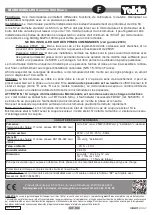
Page 5 of 26
CX-33PS Advanced Logic Control Relay & Power Supply Cabinet
INSTALLATION INSTRUCTIONS
Wire the inside momentary switch to DRY 3 input. An optional
Key switch can be added for use by tenants - wire to either DRY
1 (to unlock only), or DRY 3 (to unlock and open door). DRY 4
Input is used if you wish to connect a Fire Alarm Panel.
Output #1 is for the electric lock, and Output #2 is for the
door operator. Once input and output connections are made,
program the unit according to the General Programming
Instructions on page 1, and walk-test the installation. Timing
adjustments may need to be made.
In addition, you can add a “Delay-on-activate” (or nuisance
delay) to this mode by setting time via Step 8 of the Program
Mode. If this feature is used, any input will have to be held for
at least the time indicated on the display before the CX-33 will
activate. If this feature is not wanted, set the time to zero (0.0)
Once the desired operation is achieved, proceed to Section 4,
(Page 9) for System Inspection Instructions.
Section 3 G
Normally Unlocked Restroom (Mode 7)
In this mode, control of a single occupant barrier-free
washroom is obtained. It allows the user to lock and secure
the door from the inside by depressing a Push-to-Lock button
(once door is in the closed position). The exterior wall switch
is removed electronically from the circuit.
To exit the washroom, simply exit manually via the store-
room function lever-handle set (the Door Contact Switch
resets the relay), or, press the interior wall switch to unlock
and signal the door operator. The door remains unlocked
upon closure (see Mode 8 for normally locked doors). The
CX-33 also provides a relay dedicated for “Occupied” & “Door
Locked” signage.
Refer to Diagram 7, (Page 18) for the following connections.
The outside wall switch, inside wall switch, and Push-to-Lock
switch are all N.O. momentary switches. Connect as shown.
The Door Contact Switch circuit must be closed when the
door is closed and open when the door opens.
A fail-safe electric strike is recommended and connects to
Relay 1 (although a fail-secure strike can also be used).
The automatic door operator connects to Relay 2, and the
signage connects to Relay 3. (As a reminder, no power is
provided on the relay outputs – they are dry contacts).
Once input and output connections are made, program the
unit according to the General Programming Instructions on
page 1, and walk-test the installation. Timing adjustments
may need to be made.
It is NOT recommended to add the “Delay-on-activate” (or
nuisance delay) feature in this mode!
Once the desired operation is achieved, proceed to Section 4,
(Page 9) for System Inspection Instructions.
Section 3 H
Normally Locked Restroom (Mode 8)
In this mode, control of a normally locked single occupant
barrier-free washroom is obtained. It allows the user to
secure the door from the inside by depressing a Push-to-
Lock button. The exterior means of ingress is removed
electronically from the circuit.
To exit the washroom, simply exit manually via the store-
room function lever-handle set (the Door Contact Switch
resets the relay), or, press the interior wall switch to unlock
and signal the door operator. Exiting the washroom resets the
relay, and the door is re-locked upon closure.
The CX-33 also provides a relay dedicated for “Occupied &
“Door Locked” signage (recommended).
Refer to Diagram 8, (Page 19) for the following connections.
The outside means of ingress – Keypad, Key switch, or Prox-
reader, plus the inside wall switch, and Push-to-Lock switch
are all N.O. momentary devices. Connect as shown.
The Door Contact circuit must be closed when the door is
closed and open when the door opens.
A fail-secure electric strike is typically used, although a
fail-safe strike can also be used. Connect to Relay 1. The
automatic door operator connects to Relay 2, and the signage
connects to Relay 3. (As a reminder, no power is provided on
the relay outputs – they are dry contacts).
As a safety feature, the door cannot be “secured” via the
“Push-to-Lock” button until the door is completely closed
(prevents children from pressing the lock button and
running away).
Once input and output connections are made, program the
unit according to the General Programming Instructions on
page 1, and walk-test the installation. Timing adjustments
may need to be made.
It is NOT recommended to add the “Delay-on-activate” (or
nuisance delay) feature in this mode!
Once the desired operation is achieved, proceed to Section 4,
(Page 9) for System Inspection Instructions.
Section 3 J
Lock-out Relay Plus (Mode 9)
This mode combines, for the first time, a lintel mount safety
sensor lock-out relay (LOR) with a switching network (aka
make/break relay). The voltage sensing circuit can be utilized
with motors/controls up to 120 volts AC/DC. The adjustable
hold timer (lock-out) is then matched to the door closing time.
“Cancellation” inputs are provided for connection to rail-
mounted door beams.
In addition, three inputs and two relays are provided for the
switching network function.
Refer to Diagram 9, (Page 20) for the following connections.






































